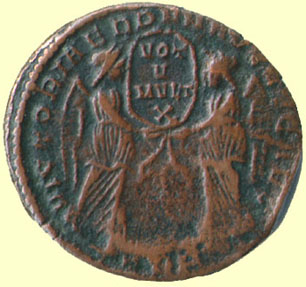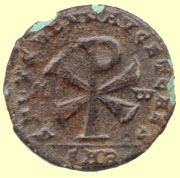 Contents -
Previous Article -
Next Article
Contents -
Previous Article -
Next Article
Magnentius
Emperor A. D. 350 - 353
Magnentius represented one of the new breed of military men that was becoming ever more commonplace as the Fourth Century progressed. Born of barbarian parents, he rose through the ranks until he became one of the emperor Constans’ top generals.
In A. D. 350, Magnentius led a rebellion in Gaul against Constans, who was obliged to flee in the face of Magnentius' superior forces. Constans got as far as the fortress of Helena at the base of the Pyrenees before he was murdered by one of Magnentius' agents. Magnentius subsequently declared himself master of the entire Western Roman Empire.
Not satisfied with what he already had taken by force, Magnentius wanted to be ruler of the whole Roman world. Accordingly, he attacked Constantius II in the East. Constantius had to conclude his war with Persia and make a quick peace treaty so he could gather his forces to face this new threat from the West. After some early successes, Magnentius was handed a severe defeat in A. D. 351 at Marsa. He was obliged to retreat to Gaul the following year as Constantius II followed up on his successes.
Magnentius was slowly being worn down by the inexorable military might of Constantius' armies. He was dealt a final, crushing defeat near Mount Seleucus on August 11, A. D. 353. His soldiers deserted him and he committed suicide along with his brother Decentius.
 Magnentius tried to enlist the sympathy of the Christians during his reign. Many of the coins struck by Magnentius and Decentius contain a large Chi Rho and the Greek letters Alpha and Omega on the reverse. They are a spectacular manifestation of how much the Church had come to dominate Roman life and politics by this time. Some of the coins are large, over 25 mm in diameter and are quite popular with collectors of Fourth Century Roman bronze coins. The example at left is approximately 25 mm in diameter and was obtained through CNG, a large auction house dealing in ancient and medieval coins in the Eastern United States.
Magnentius tried to enlist the sympathy of the Christians during his reign. Many of the coins struck by Magnentius and Decentius contain a large Chi Rho and the Greek letters Alpha and Omega on the reverse. They are a spectacular manifestation of how much the Church had come to dominate Roman life and politics by this time. Some of the coins are large, over 25 mm in diameter and are quite popular with collectors of Fourth Century Roman bronze coins. The example at left is approximately 25 mm in diameter and was obtained through CNG, a large auction house dealing in ancient and medieval coins in the Eastern United States.
Go to next article on Decentius
Go back to previous article on Constantius Gallus
Return to Roman Emperors Table of Contents
 Magnentius tried to enlist the sympathy of the Christians during his reign. Many of the coins struck by Magnentius and Decentius contain a large Chi Rho and the Greek letters Alpha and Omega on the reverse. They are a spectacular manifestation of how much the Church had come to dominate Roman life and politics by this time. Some of the coins are large, over 25 mm in diameter and are quite popular with collectors of Fourth Century Roman bronze coins. The example at left is approximately 25 mm in diameter and was obtained through CNG, a large auction house dealing in ancient and medieval coins in the Eastern United States.
Magnentius tried to enlist the sympathy of the Christians during his reign. Many of the coins struck by Magnentius and Decentius contain a large Chi Rho and the Greek letters Alpha and Omega on the reverse. They are a spectacular manifestation of how much the Church had come to dominate Roman life and politics by this time. Some of the coins are large, over 25 mm in diameter and are quite popular with collectors of Fourth Century Roman bronze coins. The example at left is approximately 25 mm in diameter and was obtained through CNG, a large auction house dealing in ancient and medieval coins in the Eastern United States.
 Contents -
Previous Article -
Next Article
Contents -
Previous Article -
Next Article